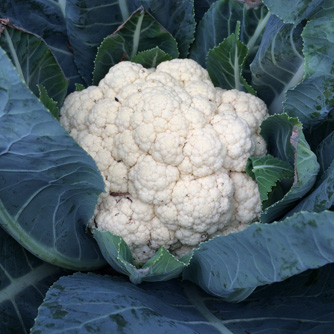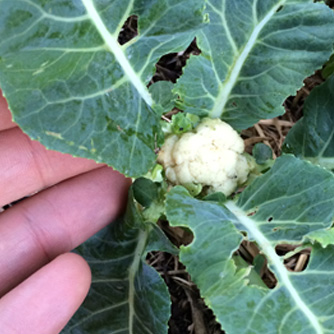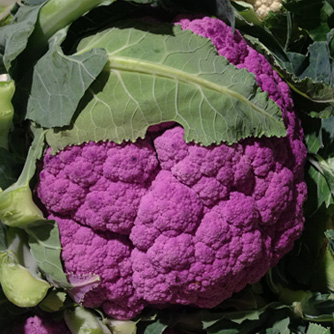Cauliflower
BackCauliflower is originally from the Mediterranean region and has been grown for thousands of years. It is closely related to broccoli and other members of the brassica family such as cabbages, Brussels sprouts and even radishes.
Cauliflowers are often overlooked by gardeners because they can take a long time to mature and take up a lot of space in the veggie patch. But the good news is there are smaller and faster growing varieties available so it’s time to give them another look!
How To Grow Cauliflower
For success with cauliflowers they need a good supply of water and nutrient. In addition they need consistent cool weather when the heads are forming. Prepare the soil with plenty of organic compost, manure and organic fertiliser as this will ensure an adequate supply of nutrient throughout the growing season. Cauliflowers don’t like an acidic soil so apply dolomite or lime to make it more alkaline. Ideally you should monitor it with a pH Testing Kit and keep the soil neutral or only slightly alkaline.
Punnets of cauliflower seedlings will be available from nurseries in season but if starting from seed then sow in trays and expect germination to take around 14 days. Plant out into the garden bed once they reach a height of about 7-10cm. Water the seedlings in with OCP eco-seaweed and mulch using an organic mulch such as sugarcane.

Cauliflower head ready to pick
Heads of cauliflowers can get sunburnt quite easily so to help protect them and keep them nice and white, tie the outer leaves together over the top of the plant to act as a sun shelter.
Sowing Guide for Cauliflower
| Growing Zone | Sowing Time |
| Cool Zones | Spring, Summer, Autumn |
| Mediterranean Zones | Summer, Autumn |
| Warm & Temperate Frost Free Zones | Summer, Autumn |
| Tropical & Subtropical Zones | Autumn, Winter |

Mini cauliflower varieties are perfect in small areas or pots
Fertilising Cauliflower
As previously mentioned cauliflowers require lots of nutrient so don’t skimp on adding compost, manure and organic fertiliser to the soil before planting out. Then, each fortnight apply a mixture of OCP eco-aminogro and OCP eco-seaweed to really push strong plant growth and bigger heads. It will have the added advantage of reduced pest and disease problems and longer shelf life to the cauliflower once picked.
Harvesting Cauliflower
Typically cauliflower heads are ready to harvest anywhere from 14-24 weeks after planting, depending on the growing conditions and the variety chosen. ‘Mini’ cauliflower varieties are faster and usually only take 10-12 weeks.
Cut the head from the plant when it is full and tightly formed before it starts to spread out. Some varieties may produce additional smaller heads so if you have the space leave the plant in the ground to see what happens. Cauliflower heads will store for a week in the refrigerator.

Yes cauliflower can be purple!
Pests and Diseases for Cauliflower
Common pest and diseases of cauliflower are:
- Caterpillars – Both the cabbage white butterfly and cabbage moth attack cauliflower so you will undoubtedly find holes in your leaves from their hungry caterpillars. Keep an eye out and regularly pick them off or spray with OCP eco-caterpillar killer.
-
Aphids and mites - These sap suckers love cauliflower and should be kept under control with an organic insecticide. Aphids can transmit a virus that stunts cauliflower growth so act quickly.
- Snails and slugs - Protect young seedlings with OCP eco-shield otherwise you'll quickly be left with bare stalks!
-
Powdery mildew - Sometimes seen on cauliflowers and can be treated with an organic fungicide. Where possible increase airflow around the plants as well.
- Nematodes - Bumpy, distorted roots is a clear sign of nematode presence resulting in yellowing leaves, repeated wilting, poor plant growth and poor yields. Apply OCP eco-nemguard at the time of planting to protect roots and reapply every 4-6 weeks for continued protection.
- Environmental conditions (usually related to hot spells) can play havoc with cauliflowers causing plants to not form proper heads or to bolt to seed. Grow at the right of time year for your location and apply OCP eco-seaweed regularly to help plants cope with heat stress.
- Nutrient deficiency can cause poor head formation and hollow stems. Prevent this with good soil preparation before planting, correcting soil pH (if needed) and regular applications of OCP eco-aminogro throughout the growing period.
There are numerous other diseases (like various rusts, rots and leaf spots) that can develop and be difficult to control once they take hold. The good news is they can usually be avoided by practicing crop rotation, ensuring adequate spacing of plants and keeping plants well fed and watered.


